青岛的英文介绍
- 格式:doc
- 大小:47.00 KB
- 文档页数:6
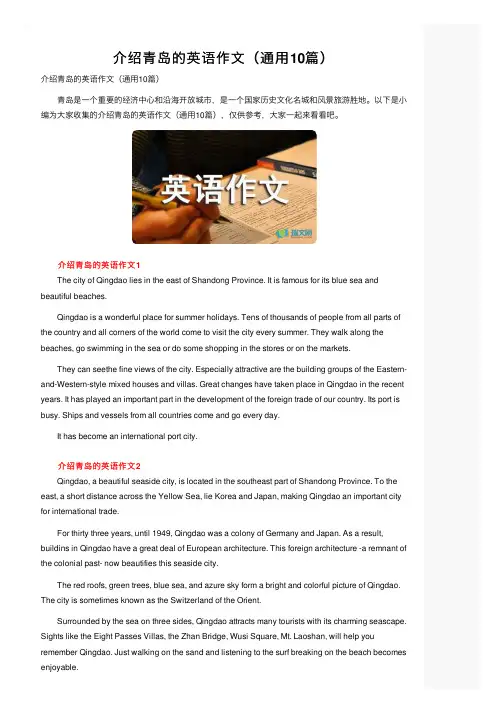
介绍青岛的英语作⽂(通⽤10篇)介绍青岛的英语作⽂(通⽤10篇) 青岛是⼀个重要的经济中⼼和沿海开放城市,是⼀个国家历史⽂化名城和风景旅游胜地。
以下是⼩篇),仅供参考,⼤家⼀起来看看吧。
编为⼤家收集的介绍青岛的英语作⽂(通⽤10 The city of Qingdao lies in the east of Shandong Province. It is famous for its blue sea and beautiful beaches. Qingdao is a wonderful place for summer holidays. Tens of thousands of people from all parts of the country and all corners of the world come to visit the city every summer. They walk along the beaches, go swimming in the sea or do some shopping in the stores or on the markets. They can seethe fine views of the city. Especially attractive are the building groups of the Eastern-and-Western-style mixed houses and villas. Great changes have taken place in Qingdao in the recent years. It has played an important part in the development of the foreign trade of our country. Its port is busy. Ships and vessels from all countries come and go every day. It has become an international port city. 介绍青岛的英语作⽂2 Qingdao, a beautiful seaside city, is located in the southeast part of Shandong Province. To the east, a short distance across the Yellow Sea, lie Korea and Japan, making Qingdao an important city for international trade. For thirty three years, until 1949, Qingdao was a colony of Germany and Japan. As a result,buildins in Qingdao have a great deal of European architecture. This foreign architecture -a remnant of the colonial past- now beautifies this seaside city. The red roofs, green trees, blue sea, and azure sky form a bright and colorful picture of Qingdao. The city is sometimes known as the Switzerland of the Orient. Surrounded by the sea on three sides, Qingdao attracts many tourists with its charming seascape. Sights like the Eight Passes Villas, the Zhan Bridge, Wusi Square, Mt. Laoshan, will help you remember Qingdao. Just walking on the sand and listening to the surf breaking on the beach becomes enjoyable. Qingdao offers food with distinctive flavors--especially seafood. So take this chance to enjoy the delicious seafood of Qingdao. Also, Qingdao is the home of the famous Qingdao (Tsingtao) Beer. Have a bottle of pure Qingdao Beer right here in Qingdao! The Qingdao Municipal Government recognizes the importance of the tourism industry and has further plans to develop tourism in Qingdao. To enhance the tourism industry, Qingdao now sponsors the Qingdao International Beer Festival, the Qingdao International Sea Festival, Beach Culture Festival, the Sea Affection Festival, and the Summer of Qingdao Festival. In cooperation with the Beijing Olympic Games 2008, Qingdao will hold the Sailing Competition in the Olympic Games in 2008. This great event brings a great opportunity for this charming city to build its bright future. 介绍青岛的英语作⽂3 Qingdao is an important economic center and coastal open cities,is a national historical and cultural cities and scenic tourism resort. The southern tip of Shandong Peninsula,Qingdao is located in an area of 10,654 square kilometers,with a total population of 6.99 million.Which the urban area of 1102 square km,population 2.24 million.Has jurisdiction over City South,City North,the Quartet,Licang,Laoshan,Shenyang City,Huangdao seven areas and Jimo,Jiaozhou,Jiaonan,roughness,Lacey five county-level d climate,a temperate monsoon climate,annual average temperature of 12.2 degrees. Filed Qingdao people often think of here is the bustling modern city and the world-famous summer resort.Qingdao set foot on this land,a dizzying variety of villas:pointed,round,high,low,stone ,.hillside beside the road were built.Yin Yin planting trees at the roadside,another expanse of Loudong red tiles,red and green Xiangying,Different scenery. 介绍青岛的英语作⽂4 The seaside resort of Qingdao extends from Tuandao in the west of Qingdao to Damaidao in the east with an overall length of 25 kilometers, including a marine area of 5 square kilometers and land area of 8.5 square kilometers. It is one of the first National Scenic Resorts appointed by the State Council in 1982. The scenery of the Zhanqiao Pier, Luxun Park, Little Qingdao Isle, Xiaoyu Hill, Badaguan, the seashore and the May Fourth Square are all beside the sea and constitute the famous scenic sights of Qingdao. Red roves and green trees, sapphire sea and blue sky in the scenic resort will make you feel happy and fresh. Zhanqiao Pier: Zhanqiao Pier, built in 1891, is the symbol of Qingdao. After several restorations, from being a simple military harbor, it is now open to tourists. The pier is 440 meters long. There is an octagonal pagoda of distinctive Chinese style, “Huilan Pagoda” at the end of the pier. From the top, tourists can fully view the magnificent sea. Along the shore is the beautiful Pier Park, which is a pleasant and quiet place for tourists to rest orenjoy the scenery of Little Qingdao Isle and its white tower. 介绍青岛的英语作⽂5 Qingdao is a good place to have fun playing. There are many places of interest there. This summer vocation, I traveled to Qingdao with my parents. 青岛是⼀个游玩的好地⽅。
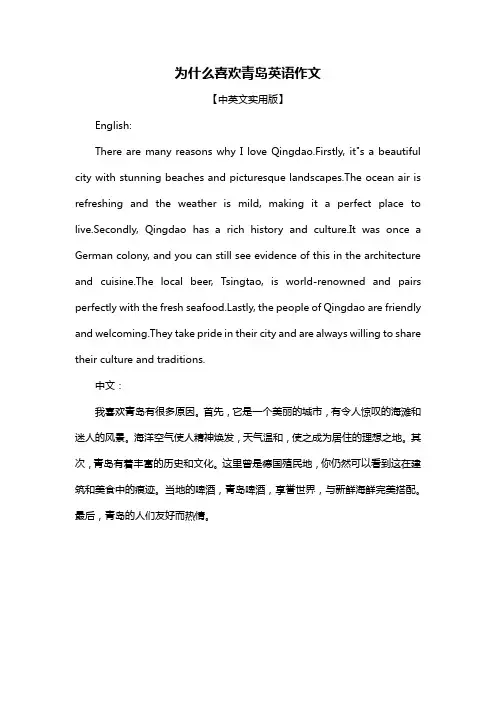
为什么喜欢青岛英语作文【中英文实用版】English:There are many reasons why I love Qingdao.Firstly, it"s a beautiful city with stunning beaches and picturesque landscapes.The ocean air is refreshing and the weather is mild, making it a perfect place to live.Secondly, Qingdao has a rich history and culture.It was once a German colony, and you can still see evidence of this in the architecture and cuisine.The local beer, Tsingtao, is world-renowned and pairs perfectly with the fresh stly, the people of Qingdao are friendly and welcoming.They take pride in their city and are always willing to share their culture and traditions.中文:我喜欢青岛有很多原因。
首先,它是一个美丽的城市,有令人惊叹的海滩和迷人的风景。
海洋空气使人精神焕发,天气温和,使之成为居住的理想之地。
其次,青岛有着丰富的历史和文化。
这里曾是德国殖民地,你仍然可以看到这在建筑和美食中的痕迹。
当地的啤酒,青岛啤酒,享誉世界,与新鲜海鲜完美搭配。
最后,青岛的人们友好而热情。
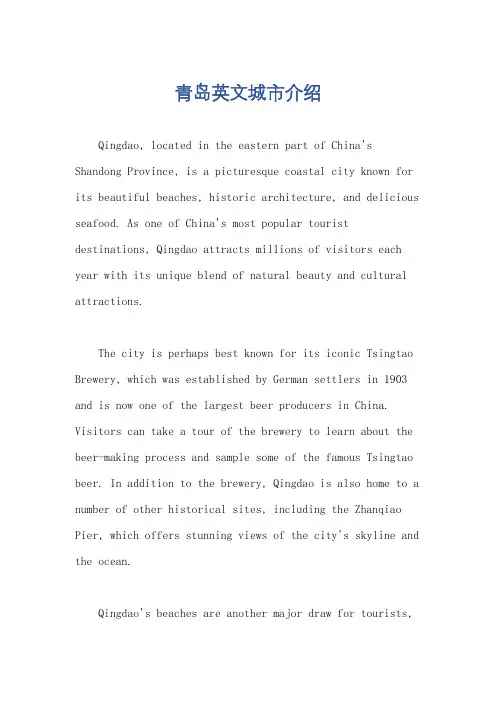
青岛英文城市介绍Qingdao, located in the eastern part of China's Shandong Province, is a picturesque coastal city known for its beautiful beaches, historic architecture, and delicious seafood. As one of China's most popular tourist destinations, Qingdao attracts millions of visitors each year with its unique blend of natural beauty and cultural attractions.The city is perhaps best known for its iconic Tsingtao Brewery, which was established by German settlers in 1903 and is now one of the largest beer producers in China. Visitors can take a tour of the brewery to learn about the beer-making process and sample some of the famous Tsingtao beer. In addition to the brewery, Qingdao is also home to a number of other historical sites, including the Zhanqiao Pier, which offers stunning views of the city's skyline and the ocean.Qingdao's beaches are another major draw for tourists,with popular spots like the sandy shores of Golden Beach and the rocky cliffs of Laoshan attracting sun-seekers and outdoor enthusiasts alike. The city's mild climate makes it an ideal destination for beachgoers, with warm summers and mild winters providing year-round opportunities for swimming, surfing, and sunbathing.In addition to its natural beauty and historical sites, Qingdao is also known for its vibrant food scene, with a wide range of restaurants serving up fresh seafood, traditional Chinese dishes, and international cuisine. The city's seafood markets are a must-visit for foodies, offering a chance to sample local specialties like grilled squid, steamed clams, and fried fish. For those looking for a taste of home, Qingdao also has a number of Western restaurants and cafes serving up burgers, pizza, and other familiar fare.Beyond its tourist attractions, Qingdao is also a bustling metropolis with a thriving economy and a rich cultural heritage. The city is home to a number of universities, museums, and art galleries, making it a hubfor education and the arts in the region. Qingdao's annual International Beer Festival and International Sailing Week draw visitors from around the world, showcasing the city's reputation as a center for international events andcultural exchange.Overall, Qingdao is a city that offers something for everyone, whether you're interested in history, food, nature, or culture. With its stunning coastline, historic architecture, and vibrant atmosphere, Qingdao is a must-visit destination for anyone looking to experience the best of what China has to offer.。
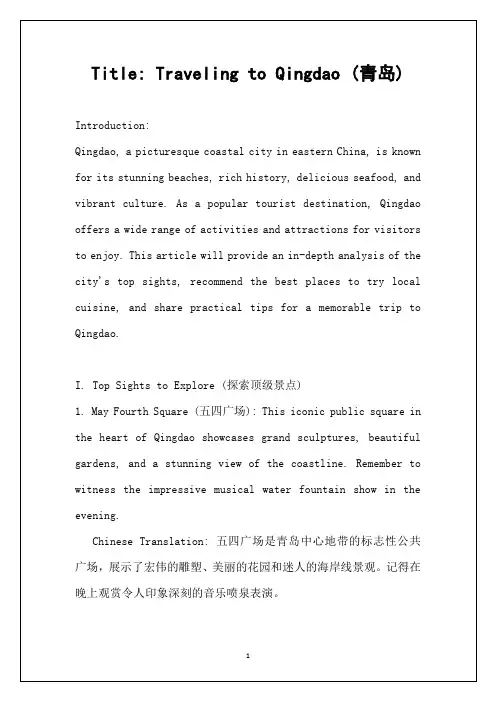
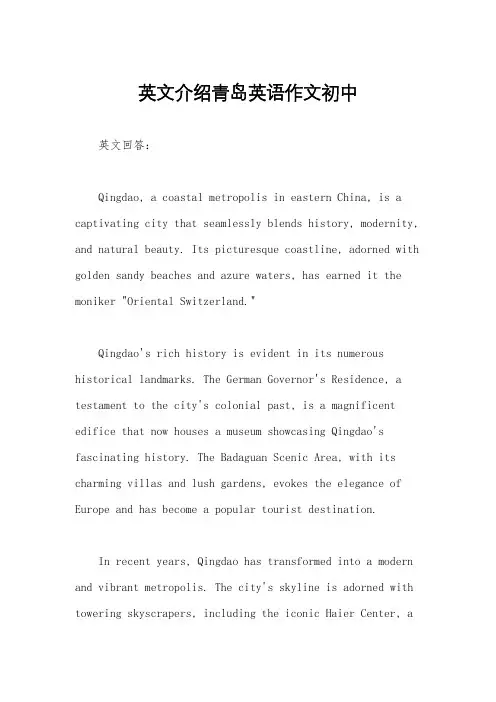
英文介绍青岛英语作文初中英文回答:Qingdao, a coastal metropolis in eastern China, is a captivating city that seamlessly blends history, modernity, and natural beauty. Its picturesque coastline, adorned with golden sandy beaches and azure waters, has earned it the moniker "Oriental Switzerland."Qingdao's rich history is evident in its numerous historical landmarks. The German Governor's Residence, a testament to the city's colonial past, is a magnificent edifice that now houses a museum showcasing Qingdao's fascinating history. The Badaguan Scenic Area, with its charming villas and lush gardens, evokes the elegance of Europe and has become a popular tourist destination.In recent years, Qingdao has transformed into a modern and vibrant metropolis. The city's skyline is adorned with towering skyscrapers, including the iconic Haier Center, asymbol of Qingdao's thriving technology industry. The city is also home to prestigious universities and research institutions, contributing to its reputation as a hub for education and innovation.Qingdao is renowned for its pristine natural surroundings. The Laoshan Scenic Area, a UNESCO World Heritage Site, boasts spectacular mountain landscapes, lush forests, and ancient temples. The Golden Beach, stretching for miles along the coastline, offers visitors an idyllic haven for swimming, sunbathing, and water sports.中文回答:青岛,中国东部的一座沿海大都市,是一座迷人的城市,它无缝地融合了历史、现代和自然美。
![青岛的英文介绍[大全]](https://uimg.taocdn.com/293d41c481eb6294dd88d0d233d4b14e85243e17.webp)
青岛的英文介绍青岛介绍Introduction to Qingdao青岛依山傍海,风光秀丽,气候宜人。
红瓦、绿树、碧海、蓝天交相映出青岛美丽的身姿;赤礁、细浪、彩帆、金色沙滩构成青岛美丽的风景线;历史、宗教、民俗、风土人情、节日庆典赋予了青岛旅游丰富的文化内涵。
浓缩近代历史文化的名人故居;具有典型欧式风格的各国建筑,形成了在中西合璧的特色。
青岛以海鲜为主的独特饮食,新鲜清淡为特色,备受欢迎。
崂山绿石,天然珍珠,精巧的草制工艺品,更受旅游者的青睐。
青岛还是闻名海内外的青岛啤酒的原产地,游人在这里可以品尝到正宗新鲜的青岛啤酒。
Qingdao has beautiful scenery and pleasant climate. A harmonious picture of mountains, sea and city is painted in which one can see the winding coastline, islands and beautiful buildings whose red-roofs are held in the embrace of verdant trees. Many of the European-style buildings used to be home to many famous figures.Qingdao is famous in China for its delicious fresh seafood. The Laoshan Scenic Area has an important position in sightseeing because of its beautiful scenery, natural pearls and exquisite crafts. Qingdao beer (Tsingtao beer), a popular beer brand in the world, is produced in Qingdao, allowing tourists to easily get the freshest Qingdao Beer in Qingdao.地理位置:青岛地处太平洋西岸,东经119°30’-121°00’,北纬35°35’-37°09’,滨临黄海,东与朝鲜半岛、日本隔海相望,是山东及沿黄河流域最大的出海口。
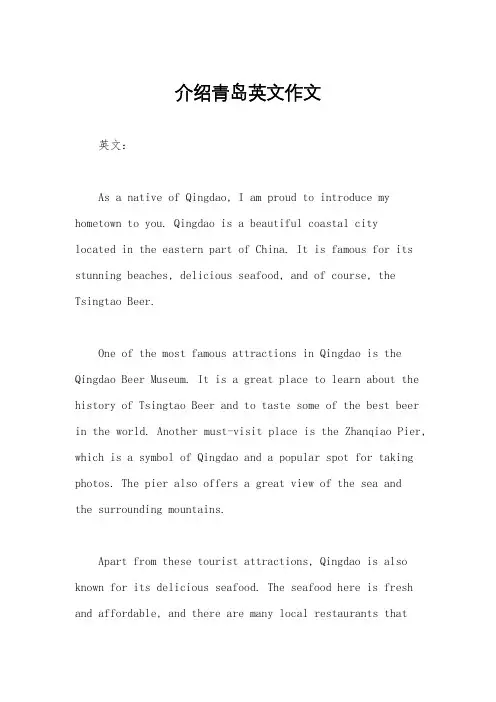
介绍青岛英文作文英文:As a native of Qingdao, I am proud to introduce my hometown to you. Qingdao is a beautiful coastal citylocated in the eastern part of China. It is famous for its stunning beaches, delicious seafood, and of course, the Tsingtao Beer.One of the most famous attractions in Qingdao is the Qingdao Beer Museum. It is a great place to learn about the history of Tsingtao Beer and to taste some of the best beer in the world. Another must-visit place is the Zhanqiao Pier, which is a symbol of Qingdao and a popular spot for taking photos. The pier also offers a great view of the sea andthe surrounding mountains.Apart from these tourist attractions, Qingdao is also known for its delicious seafood. The seafood here is fresh and affordable, and there are many local restaurants thatserve a variety of dishes. Some of my favorites include the grilled squid, steamed clams, and fried shrimp.In addition to the food and attractions, Qingdao is also a great place to experience the local culture. The people here are friendly and welcoming, and there are many festivals and events throughout the year. For example, the Qingdao International Beer Festival is held every August and attracts beer lovers from all over the world.Overall, Qingdao is a beautiful and vibrant city that has something to offer for everyone. Whether you are interested in history, food, or culture, you will find something to enjoy here.中文:作为青岛本地人,我很自豪地向您介绍我的家乡。
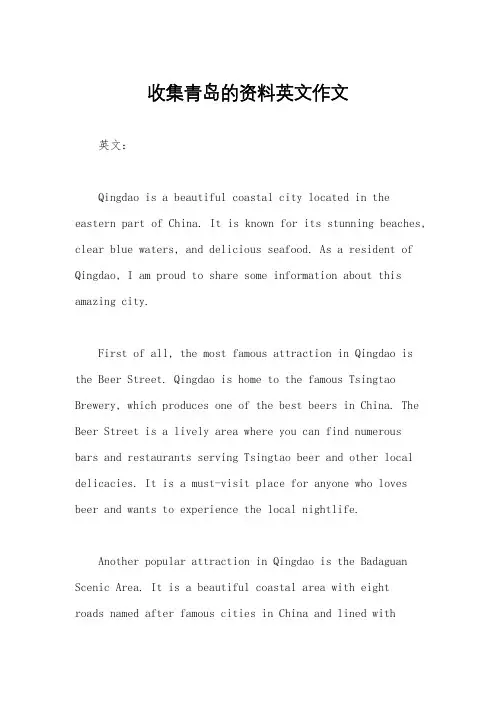
收集青岛的资料英文作文英文:Qingdao is a beautiful coastal city located in the eastern part of China. It is known for its stunning beaches, clear blue waters, and delicious seafood. As a resident of Qingdao, I am proud to share some information about this amazing city.First of all, the most famous attraction in Qingdao is the Beer Street. Qingdao is home to the famous Tsingtao Brewery, which produces one of the best beers in China. The Beer Street is a lively area where you can find numerous bars and restaurants serving Tsingtao beer and other local delicacies. It is a must-visit place for anyone who loves beer and wants to experience the local nightlife.Another popular attraction in Qingdao is the Badaguan Scenic Area. It is a beautiful coastal area with eightroads named after famous cities in China and lined withtrees and flowers. The area is known for its stunning architecture, including European-style villas andtraditional Chinese buildings. It is a great place to takea leisurely stroll and enjoy the scenery.Apart from these attractions, Qingdao is also famousfor its seafood. The city is surrounded by the sea, and the locals take full advantage of it by serving fresh and delicious seafood dishes. Some of the must-try dishesinclude steamed scallops, grilled squid, and seafood hotpot.中文:青岛是中国东部一个美丽的海滨城市。
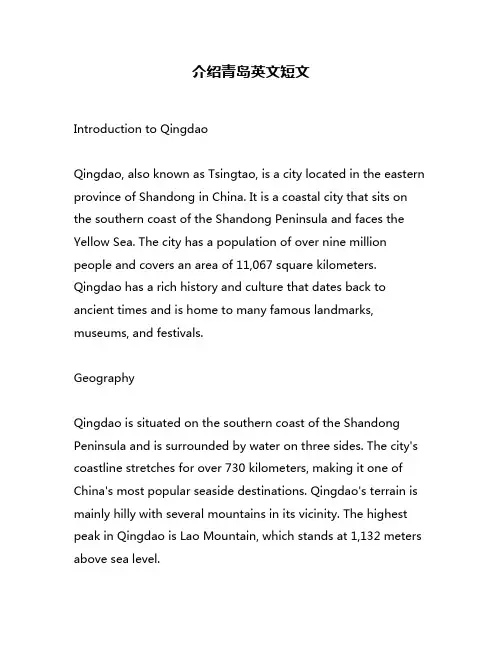
介绍青岛英文短文Introduction to QingdaoQingdao, also known as Tsingtao, is a city located in the eastern province of Shandong in China. It is a coastal city that sits on the southern coast of the Shandong Peninsula and faces the Yellow Sea. The city has a population of over nine million people and covers an area of 11,067 square kilometers. Qingdao has a rich history and culture that dates back to ancient times and is home to many famous landmarks, museums, and festivals.GeographyQingdao is situated on the southern coast of the Shandong Peninsula and is surrounded by water on three sides. The city's coastline stretches for over 730 kilometers, making it one of China's most popular seaside destinations. Qingdao's terrain is mainly hilly with several mountains in its vicinity. The highest peak in Qingdao is Lao Mountain, which stands at 1,132 meters above sea level.ClimateQingdao has a temperate climate that is influenced by its proximity to the ocean. The city experiences four distinct seasons with mild temperatures throughout the year. Summers are warm and humid with an average temperature of 25°C while winters are cold and dry with an average temperature of -2°C.CultureQingdao has a rich cultural heritage that dates back to ancient times. The city's culture has been shaped by its history as a port city and its interactions with other cultures from around the world. One of Qingdao's most famous cultural exports is Tsingtao Beer, which was first brewed in the city in 1903. Other notable cultural landmarks include the Zhanqiao Pier, which was built during the early 20th century and served as a gateway for foreign goods entering China.TourismQingdao is one of China's most popular tourist destinations dueto its beautiful coastline, rich culture, and history. Some of the city's most popular tourist attractions include the Badaguan Scenic Area, which is known for its European-style architecture, and the Qingdao Beer Museum, which showcases the history of Tsingtao Beer. The city is also home to several festivals throughout the year, including the Qingdao International Beer Festival, which attracts visitors from around the world.EconomyQingdao has a diversified economy that is driven by several industries, including manufacturing, finance, and tourism. The city is home to several large corporations, including Haier and Hisense. Qingdao's port is one of China's busiest and serves as a major hub for international trade.TransportationQingdao has an extensive transportation network that includes air, rail, and road. The city's airport serves both domestic and international flights and is located approximately 30 kilometers from the city center. Qingdao also has a well-developed public transportation system that includes buses and subways.ConclusionQingdao is a beautiful coastal city with a rich history and culture that attracts visitors from around the world. Its stunning coastline, cultural landmarks, festivals, and diversified economy make it one of China's most popular tourist destinations. With its well-developed transportation network and temperate climate, Qingdao offers visitors an unforgettable experience that combines history, culture, and natural beauty.。
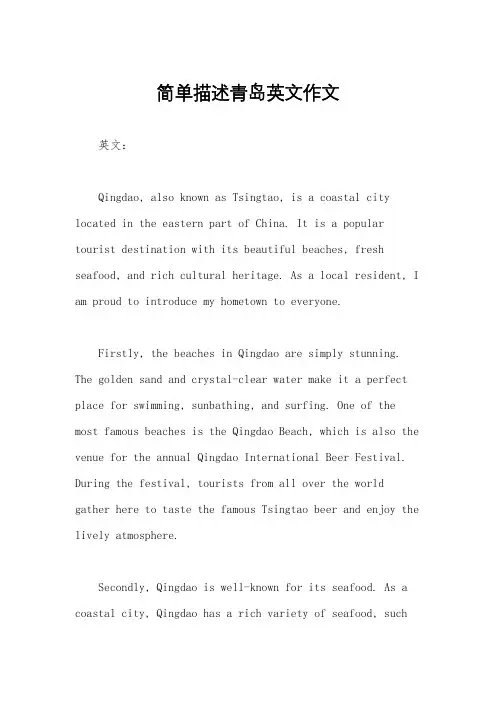
简单描述青岛英文作文英文:Qingdao, also known as Tsingtao, is a coastal city located in the eastern part of China. It is a popular tourist destination with its beautiful beaches, fresh seafood, and rich cultural heritage. As a local resident, I am proud to introduce my hometown to everyone.Firstly, the beaches in Qingdao are simply stunning. The golden sand and crystal-clear water make it a perfect place for swimming, sunbathing, and surfing. One of the most famous beaches is the Qingdao Beach, which is also the venue for the annual Qingdao International Beer Festival. During the festival, tourists from all over the world gather here to taste the famous Tsingtao beer and enjoy the lively atmosphere.Secondly, Qingdao is well-known for its seafood. As a coastal city, Qingdao has a rich variety of seafood, suchas prawns, crabs, and fish. The local cuisine is famous for its freshness and delicious taste. One of my favoritedishes is the spicy prawns, which are cooked with a special sauce and served with a bowl of rice.Lastly, Qingdao has a rich cultural heritage. The city was once a German colony, and the influence of German architecture can still be seen in some of the buildings.The most iconic landmark is the Zhanqiao Pier, which wasbuilt in 1891 and has become a symbol of Qingdao. In addition, Qingdao is also home to the famous Tsingtao Brewery, which was founded in 1903 and has become one ofthe most well-known beer brands in the world.中文:青岛,也称为“青岛”,是位于中国东部的一个沿海城市。
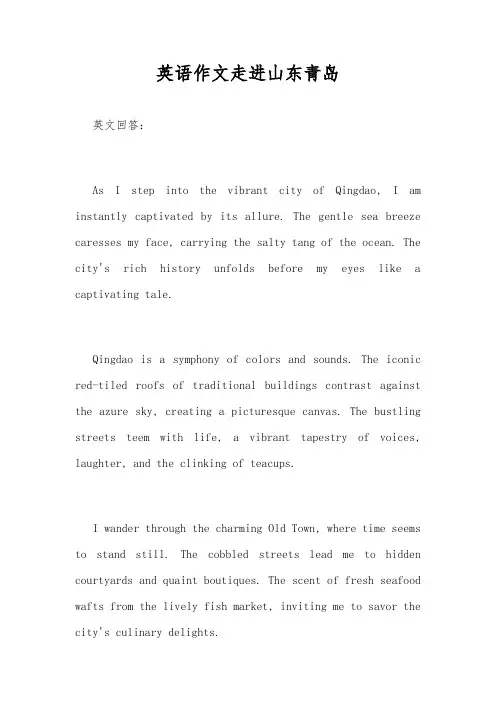
英语作文走进山东青岛英文回答:As I step into the vibrant city of Qingdao, I am instantly captivated by its allure. The gentle sea breeze caresses my face, carrying the salty tang of the ocean. The city's rich history unfolds before my eyes like a captivating tale.Qingdao is a symphony of colors and sounds. The iconic red-tiled roofs of traditional buildings contrast against the azure sky, creating a picturesque canvas. The bustling streets teem with life, a vibrant tapestry of voices, laughter, and the clinking of teacups.I wander through the charming Old Town, where time seems to stand still. The cobbled streets lead me to hidden courtyards and quaint boutiques. The scent of fresh seafood wafts from the lively fish market, inviting me to savor the city's culinary delights.As I reach the waterfront, the majestic Tsingtao Beer Museum beckons me. Its grand architecture and captivating exhibits tell the captivating story of the world-famous Tsingtao beer. I raise a glass in appreciation of this iconic local brew.The city's natural beauty is equally enchanting. I marvel at the rugged grandeur of Laoshan Mountain, a UNESCO World Heritage site. Its towering peaks and serene lakes offer breathtaking views. The sandy beaches of Golden Sand Beach invite me to bask in the warm sunshine and feel the sand between my toes.Qingdao is more than just a city; it is a rich tapestry of culture, history, and natural wonders. It is a place where the past and present intertwine, creating a vibrant and unforgettable experience. As I bid farewell to this enchanting city, I carry with me cherished memories and a yearning to return.中文回答:当我走进充满生机的青島市,它的魅力瞬間俘虜了我的心。
青岛英文介绍作文英文:As a coastal city in China, Qingdao is a beautiful and vibrant place with a rich history and culture. The city is famous for its stunning beaches, delicious seafood, and of course, the internationally renowned Qingdao beer. 。
One of the things I love most about Qingdao is its beautiful coastline. The city is surrounded by the sea on three sides, and the beaches here are absolutely stunning. One of the most popular beaches is the iconic Golden Beach, with its soft golden sand and clear blue waters. It's the perfect place to relax, soak up the sun, and enjoy the fresh sea breeze.Another thing that makes Qingdao special is its delicious seafood. The city's location on the coast means that there is an abundance of fresh seafood available, and the local restaurants serve up some of the best seafooddishes I've ever tasted. From steamed fish to grilled squid, there's something for every seafood lover here.And of course, I can't talk about Qingdao without mentioning Qingdao beer. The city is home to the famous Tsingtao Brewery, one of the largest beer producers in China. The brewery offers tours where visitors can learn about the beer-making process and, of course, sample someof the delicious brews.中文:作为中国的一个沿海城市,青岛是一个美丽而充满活力的地方,拥有丰富的历史和文化。
Qingdao -- Coastal ResortLying on the south coast of the Shandong Peninsula, Qingdao is a city of picturesque red-tiled roofs nestled between green hills and blue sea. The mild climate, the bathing beach, and Mount Laoshan make Qingdao a popular health and holiday resort, particularly in summer when visitors come here in droves for sightseeing and escaping the heat.Qingdao is also an industrial city and a major foreign trade port. Its mineral water, wine, and excellent Tsingtao Beer are world-famous. Among the local arts and crafts, shell carvings are especially popular with tourists.★An Important Coastal City in East ChinaQingdao is a key economic center and port city in China famous for its cultural heritage and picturesque scenery.Qingdao is one of China's top ten economically dynamic cities and top ten business cities. It is the winner of the country's "Entrepreneur's Satisfaction Award".Qingdao is a national model for environmental protection, city sanitation and landscape development. It is the winner of "China Human Settlements and Environment Award".Qingdao is a sailing city in China. The 29th Olympic sailing regatta will be held here in 2008.Qingdao is one of the 14 coastal cities opening up to the outside world and one of the eight cities authorized to hold international conferences.Qingdao is one of China's major seaports for foreign trade.Qingdao is an important base for marine science research in China.★Geographic Location and Natural EnvironmentQingdao is located at the southern tip of the Shandong Peninsula (35'35' ~ 37'09'N, 119'30'~121'00'E). It is characterized by a unique blend of sea and mountains and a pleasant climate. Qingdao has a total coastline (including its islands) of 870 kilometers, 730 kilometers of which are continental coastline, accounting for one fourth of the total length in Shandong Province. There are numerous capes and coves along the zigzag coastline.Qingdao has seven urban districts and five county-level cities under its jurisdiction with a total area of 10,654 square kilometers and a population of 7,311,200. The urban area measures 1,102 square kilometers and urban residents total 2,584,000.Qingdao lies in the North Temperate Zone and has the typical temperate monsoon climate. Under the direct influence of the southeastern monsoon and the sea currents and tides, the city proper features marked marine climate ? humid air, mild temperature and clear-cut seasons. In spring, the weather becomes warmer slowly, usually one month later than the inland areas. It is humid and rainy in summer, but is free from fiercely hot days, while cool and dry in autumn. Winter here is long and usually windy but not unbearably cold.★URBAN CONSTRACTION and PLANNINGTargeting at a " world-renowned city with distinctive features" and a " national key center city", Qingdao's focus is on develop the three economic fields of port, tourism and marine science as well as on the construction of the four industrial bases for home appliances and electronics, petrochemicals, automobile, locomotive manufacturing and shipbuilding and new materials. Qingdao is currently developing six industrial clusters for home appliances, electronic information, petrochemicals, automobile, shipbuilding and port as well as building a regional shipping center, logistics center, service center, financial center and high-tech industrial center.Qingdao's development is based on the concept of "three-point layout", "one-line planning" and "group development strategy". The "three-point layout" refers to the development of the Jiaozhou Bay region relying on the three basic points of the old urban district of Qingdao, Huangdao and Hongdao, and the construction of the new urban district by connecting the three points with a trans-oceanic bridge or undersea tunnel and the Jiaozhou Bay Expressway. The "one-line planning" refers to building a coastal highway from Langyatai in Jiaonan to Tianhengdao Island in Jimo, which will connect all parts of the city to form a main urban development belt. The "group development strategy" refers to the expansion of business groups on both sides of the coastal highway. There will be seven development groups respectively in Tianhengdao Island, Aoshan, Zhucheng, Hongdao, Huangdao, Jiaonan and Langyatai, which will push forward the urbanization of the adjacent regions.To carry out the west coast development strategy: this involves the westward relocation of the port, and the construction of an "international port" and an international transshipment port. It will promote investment in large projects and the emergence of a new economic center on the west coast.To construct "five areas": by adjusting the productivity layout, a development mode will be established in five areas: the city's west coast and east coast, the North bank of the Jiaozhou Bay, the suburban areas and the old urban area. The plan will be carried out in strict accordance with administration layout adjustment .★QINGDAO and THE OLYMPICSQingdao is an athletic and soccer town, and its people have a strong liking for sports. In 2004, Qingdao athletes won a total of 227 gold medals, 182 silver medals, and 147 bronze medals, and broke three national records in sports competitions at all levels.As the host city for the 29th Olympic sailing regatta in 2008, Qingdao has begun making overall plans for the Olympic sailing facilities based on its gifted landscape of "mountain, sea and city" as well as the harmony between man and nature in order to improve the ecological environment and hold a "Green, - High-tech and the People's Olympics" with unique Qingdao characteristics. By building an international water sports center with first-class sailing facilities in Asia, which is among the leading sailing countries in the world, we will characterize Qingdao as the "Marine Olympics" city and build Qingdao into a Sailing City.By June 2004, the plan and architectural design for the Olympic Water Sports Center will be finalized. The relocation of the Beihai Shipyard and construction preparations were finished, and some infrastructure construction work was started. By June 2006, the Olympic Water Sports Center and its related supporting facilities will be fundamentally completed, and the construction of urban infrastructure facilities will commence in an all-round way. By June 2008, all the Olympic-related construction will becompleted in accordance with the Olympic sailing requirements. The pre-Olympic sailing games will be held. From July to December 2008, the Olympic sailing regatta and the Para-Olympics will take place here.★Water Sports CenterThe 2008 Olympic sailing venue is located in the Fushan Bay near the city's political, cultural and commercial center. The land facilities will cover approximately 45 hectares and will include a national sailing center, an Olympic village, an athlete center, a boating park, a media center, an international passenger liner terminal, an international conference center, a five-star hotel, an international yacht club, a seaside marina, a shopping and amusement center, some parks and public squares. The comprehensive Water Sports Center will accommodate tourist sightseeing, body-building and recreational activities. Upon its completion, a new waterborne sports industry together with the relevant recreation facilities will be typical of Qingdao.。
Sailing City ,Charming Qingdao奥帆之都,魅力青岛Qingdao is a quaint seaside city on the southern tip of the Shandong 青岛是一座位于山东半岛南端的美丽的海滨城市peninsula. Covering an area of 10,654sq km, it has jurisdiction over城市面积10654平方千米,其管辖范围有七个区,五个县级市seven districts and five county-level cities,totaling a population of总人口850万8.5million.With numerous historical sites and picturesque scenery,Qingdao is a 青岛是一个闻名的旅游胜地,因其无数的历史遗迹和如画般的景色,well-known travel destination that attracts more than 40 million tourists each year. 每年吸引了超过四千万的旅客。
Qingdao is acknowledged as the Sailing City of China ,and was the host 作为中国的帆船之都,青岛举办了2008年北京奥运会的帆船项目和残奥会。
city for all sailing events during the 2008Beijing Olympic Games and Paralymic Games.As a coastal city,Qingdao takes full advantage of its ports and oceanic 作为一个海滨城市,青岛充分利用了他的港口和海洋资源。
resources. The city’s economic aggregate remains at the forefront of这座城市的经济总量保持在中国大中型城市的前沿。
青岛英文介绍作文Qingdao, also known as Tsingtao, is a coastal city located in the eastern part of China. It is a popular tourist destination for its beautiful beaches, historic architecture, and delicious seafood.The city is famous for its beer, which is brewed by the Tsingtao Brewery. Visitors can take a tour of the brewery and learn about the history of beer production in the city. The brewery also hosts an annual beer festival, which attracts thousands of visitors from around the world.Qingdao is home to many historic buildings, including the German Governor's Residence and the Badaguan Scenic Area. The German Governor's Residence was built in the early 1900s and is a beautiful example of German architecture. The Badaguan Scenic Area is a neighborhood that features streets lined with trees and historic buildings.The city is also known for its seafood. Visitors can enjoy fresh seafood at one of the many restaurants located along the coast. Some of the most popular dishes include grilled squid, steamed clams, and fried shrimp.Qingdao is a great place to relax and enjoy the beach. The city has several beaches, including the popular Qingdao Beach and Shilaoren Beach. Visitors can swim, sunbathe, and participate in water sports such as surfing and windsurfing.In addition to its natural beauty and historic architecture, Qingdao is also a modern city with a vibrant nightlife. The city has many bars and nightclubs where visitors can enjoy live music and dance the night away.Overall, Qingdao is a must-visit destination for anyone traveling to China. With its beautiful beaches, historic architecture, delicious seafood, and vibrant nightlife,there is something for everyone in this coastal city.。
青岛的英文介绍以下英文部分简单介绍了青岛的概况,包括:地理位置,名字由来,区市分划,地理气候,历史,人口,经济,交通,文化,旅游,教育,体育等。
Qingdao (help·info) (Simplified Chinese: 青岛; Traditional Chinese: 青岛; pinyin: Qīngdǎo; Wade-Giles: Ch'ing-tao), well-known to the West by its Postal map spelling Tsingtao, is a sub-provincial city in eastern Shandong province, People's Republic of China. It borders Yantai to the northeast, Weifang to the west and Rizhao to the southwest. Lying across the Shandong Peninsula while looking out to the Yellow Sea, Qingdao today is a major seaport, naval base, and industrial center. It is also the site of the Tsingtao Brewery. The name "Qingdao" in Chinese means "Green Island".Additional NamesQingdao was formerly known as Jiao'ao (胶澳).Qindao (琴岛; lit. "Stringed Instrument Isle") is an additional modern name for the area which according to locals refers to the shape of the coastline.AdministrationThe sub-provincial city of Qingdao administers 12 county-level divisions, including 7 districts and 5 county-level cities.Shinan District (市南区)Shibei District (市北区)Sifang District (四方区)Licang District (李沧区)Laoshan District (崂山区)Chengyang District (城阳区)Huangdao District (黄岛区)Jimo City (即墨市)Jiaozhou City (胶州市)Jiaonan City (胶南市)Pingdu City (平度市)Laixi City (莱西市)Geography and climateLocation within ChinaQingdao is located at the southern tip of the Shandong Peninsula. It borders three prefecture-level cities, namely Yantai to the northeast, Weifang to the west, and Rizhao to the southwest. The city's total jurisdiction area occupies 10 654 km2. The geography of the city is relatively flat while mountains spur up nearby. The highest elevation in the area is 1133 m above sea level. The city has a 730.64-kilometer coastline. Five significant rivers that flow for more than50 km can be found in the region.Qingdao enjoys mild summers and relatively warm winters, with the average July temperature at 23.8°C and the average January temperature at -0.7°C. The city gets most rain in June and July, at an average of 150 mm.HistoryFor details on the colonial period, see Jiaozhou BayThe area of which Qingdao is located today was called Jiao'ao (胶澳) when it was administered by the Qing Dynasty. In 1891, the Qing Government decided to make the area a primary defence base against naval attacks, and planned the construction of a city. Little was done, however, until 1897 when the city was ceded to Germany (after Hong Kong fell under British control and Macau went to the Portuguese). The Germans soon turned Tsingtao into a strategically important port, basing their Pacific Squadron there, allowing the fleet to conduct operations throughout the Far East. The German Imperial government planned and built the first streets and institutions of the city we see today, including the world-famous Tsingtao Brewery. German influence extended to other areas of Shandong Province, including the establishment of rival breweries.Map of Qingdao in 1912Soon after the outbreak of World War I, the German Pacific Squadron, under Admiral Graf von Spee, left Tsingtao rather than waiting to be trapped in the harbour by Allied forces. After a subsequent minor British naval attack on the German colony in 1914, Japan occupied the city and the surrounding province during the Battle of Tsingtao after Japan's declaration of war on Germany. The failure of the Allied powers to restore Chinese rule to Shandong after the war triggered the May Fourth Movement.The city reverted to Chinese rule in 1922, under control of the Kuomintang (the ROC). Renamed Qingdao in 1930, the city became a special administrative zone of the ROC Government. Japan re-occupied Qingdao in 1938 with its plans of territorial expansion onto China's coast. After World War II the KMT allowed Qingdao to serve as the headquarters of the Western Pacific Fleet of the US Navy. On 2nd June, 1949, the CCP-led Red Army entered Qingdao and the city and province have been under PRC control since that time.Since the 1984 inauguration of China's open-door policy to foreign trade and investment, Qingdao has developed quickly as a modern port city. It is now the headquarters of the Chinese navy's northern fleet.Qingdao is now a manufacturing center, and home to Haier Corporation a major electronics firm. The city has recently experienced a rapid growing period, with a new central business district created to the east of the older business district. Outside of the center of the city there is a large industrial zone, which includes chemical processing, rubber and heavy manufacturing, in addition to a growing high tech area.[edit] DemographicsBy the end of 2002, Qingdao is estimated to be the home for more than 7 million inhabitants, of which around 2.6 million reside in the Qingdao urban area. Another estimated 2.3 million reside in other cities under Qingdao's jurisdiction. The annual number of births is calculated around 82,000, with a birth rate of 11.26/1000 population, and a death rate of 6.93/1000 population, both calculated on an annual basis. This results to a 4.33/1000 population growth rate overall, not counting immigration, which is substantial. Living standards are among highest of the leading Chinese cities due to the strong export economy and relatively high family wages.While Qingdao is home to 38 Chinese ethnic minorities they constitute only 0.14% of the city's total population. Qingdao boasts a vibrant expatriate community, led by the Korean community which comprised over 60,000 individuals in 2005.EconomyQingdao is perhaps most famously known for the Tsingtao Brewery, which German settlers founded in 1903, and which produces Tsingtao beer, now the most famous beer in China and known worldwide.Qingdao May 4th Square [2006]In 1984 the Chinese government named a district of Qingdao a Special Economic and Technology Development Zone (SETDZ). Along with this district, the entire city had gone through amazing development of secondary and tertiary industries. As an important trading port in the province, Qingdao flourishes with foreign investment and international trade. South Korea and Japan in particular made extensive investment in the city. At least 30,000 South Korean nationals reside there. Construction proceeds at a relatively fast pace in Qingdao. Famous corporations include Haier.In terms of primary industry, Qingdao has an estimated 50,000 acres (200 km2) of arable land. Qingdao has a zig-zagging pattern coastline, and thus possesses an invaluable stock of fish, shrimp, and other sea resources. Qingdao is also home to a variety of mineral resources. Up to thirty different kinds have been mined. Qingdao's wind power electricity generation performs at among the best levels in the region.The GDP per capita comprised ¥29,596 (ca. US$3,659) in 2004. The GDP has grown steadily at an average pace of 14% annually.[edit] TransportationThe Orient Ferry connects Qingdao with Shimonoseki, Japan. There are numerous smaller ferries connecting Qingdao with South Korea as well.The Qingdao Liuting International Airport, 36 kilometres away from city centre, is served by 13 domestic and international airlines, operating 58 routes of which 10 are international and regional. It is estimated that in 2002 over 2.3 million people, including 450,000 international travelers, were transported through the airport.Qingdao hosts one of China's largest seaports. Cooperative relations have been established with 450 ports in 130 countries worldwide. The 1999 annual cargo handling capacity was 72 million tons. Exported commodities amounted to more than 35 million tons and 1.5 million TEUs.Qingdao's railway development was picked up during the late 90's. At the present, domestic rail lines connect Qingdao with Lanzhou, Chengdu, Xi'an, Zhengzhou, Jinan and Jining. There are a total of 1,145km of roads in the Qingdao area, with nearly 500km of expressways. Expressways connect Qingdao with Jinan. The specially designed high-altitude railcars required for the Qinghai–Tibet railway, the highest railway in the world, are also built in Qingdao.[edit] CultureThrough the unique combination of German and Chinese architecture in the city center, combined with modern high-rises and freeways, along a coastline of beaches, rocky headlands, and picturesque cypress trees, give Qingdao a distinct atmosphere not found anywhere else in the world. Qingdao is proud to be the host city for several events of the 2008 Olympics, including the sailing competitions which will take place along the complicated shoreline directly offshore from the city.Unlike many large Chinese cities with a long history, Qingdao is a relative newcomer, being nothing but a fishing village in 1897. The majority of residents are immigrants having migrated from other locations to take advantage of the opportunities Qingdao offers. Nonetheless a distinctive local accent known as "Qingdao Hua" distinguishes the residents of the city from those of the surrounding province (who speak "Shandong Hua", both being dialects of Mandarin).The distinctive cuisine is Lu Cai, the Shandong regional style.The area's most famous festival is the Qingdao International Beer Festival, held annually since 1991.[edit] TourismQingdao attracts many tourists due to its seaside setting and excellent weather. Parks, beaches, sculpture and some unique architecture line the shore. For more information head over to the Qingdao Information Center for International Visitors located on XiangGang Zhong Lu. Qingdao's major attractions include:Zhan Qiao (Pier)Ba Da Guan (Eight Great Passes), the older area of town with some surviving German and Japanese architecture.May Fourth Square Coastal plaza with the Wind of May sculptureLu Xun Park, named after Lu Xun, a famous modern Chinese writer.Huadong WineryXiao Yu Shan (Little Fish Hill)Jiaozhou Governor's Hall, former seat of the present and previous two governments.Laoshan, a famous Taoist mountain.Qingdao Beer Museum, on the site of the old brewery.Qingdao Naval MuseumQingdao International Beer City, the primary site of the annual Qingdao International Beer Festival.Qingdao Underwater WorldSt. Michael's Cathedral, a Gothic/Roman cathedral designed by German architect Pepieruch, completed in 1934.Underground World of Chinese Mythology, lifesize figures and groups depicting scenes from the Chinese mythologyZhanshan Temple, Qingdao's only Buddhist temple.[edit] EducationPost-secondary educational institutions in Qingdao include:Ocean University of China (formerly Ocean University of Qingdao), the largest university of its kind in ChinaQingdao UniversityQingdao University of Science and TechnologyQingdao Technological UniversityShandong University of Economics and TradeQingdao Hotel and Management CollegeLaiyang Agricultural UniversitySecondary School:Qingdao 2 high schoolQingdao No. 9 high schoolQingdao No. 17 high schoolQingdao 26 middle schoolQingdao 19 high schoolThere are also several international schools in Qingdao. These include:Qingdao International SchoolQingdao MTI International School[edit] SportsQingdao has long been a hub of professional sports in China. Clubs include:Chinese Super League (soccer)Qingdao ZhongnengChinese Football Association Jia LeagueQingdao HailifengAlong with Beijing's winning bid to host the 2008 Summer Olympics, Qingdao will be the site for sailing events. These events will be held in Fushan Bay, near the city's central business district. A hotel and an international broadcasting center are under construction.。